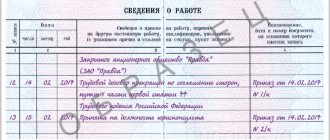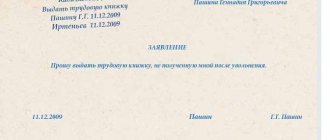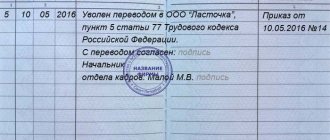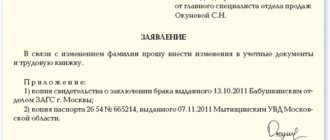When is an insert in the work book completed?
The new form of insert in the work book was approved by Order of the Ministry of Labor dated May 19, 2021 No. 320n. The procedure for issuing and processing the insert is prescribed in it (hereinafter referred to as Procedure No. 320n).
Work books and inserts of the new sample will be used from 01/01/2023. Is it necessary to exchange old workers for new ones and what to do with old-style book forms and inserts that are not used by 2023? Read here.
The insert is drawn up as part of a paper work book in the event that one of its sections is completely filled out and there is a need to further enter data into it. A correctly executed insert becomes an integral element of the book and is invalid without it (clause 32 of Order No. 320n).
The work book has 3 sections to indicate information about:
- employee (also called title page);
- work;
- employee benefits.
Thus, the HR officer may need to prepare an insert if the fields in any of the specified sections run out. At the same time, as soon as the insert is sewn into the book, you cannot continue making entries in the empty fields remaining in it - subsequent data can only be legally entered into the sections of the attached insert.
If you need to issue a duplicate work record book, use the recommendations from ConsultantPlus experts. Trial access to the legal system is free.
Most often, a personnel officer has to perform the following operations:
- filling the insert;
- sewing in the liner;
- legal registration of the use of the insert in personnel document flow.
Let's study the specifics of these procedures in more detail.
Registration and certification
The law clearly establishes the procedure for preparing inserts in work books. These inserts are subject to absolutely all the requirements applicable to the work book. The main stages of the formation of an additional labor document - an insert in the labor book form:
- If there are no more empty lines in the “Information about work” section or in the “Information about awards” section, the personnel employee is obliged to continue filling out the work book. This is done by sewing in liners.
- On the title page of the work book, a mark and stamp are placed in the upper right corner indicating that the insert was issued.
- Also, the work book must contain the number and series of the issued insert.
- The manager is obliged to provide each of his employees with work books and inserts, and each personnel officer must know how to sew the insert into the work book so that in the future there will be no problems regarding the calculation of the insurance and work experience of the owner of the work form.
- The insert is not an independent document, therefore, according to the law, it is considered that the insert without a labor document is invalid.
- If there is no stamp, you can handwrite the phrase “insert issued.” Such actions are not considered illegal, but the employer will eventually have to purchase the necessary stamp.
- The rules for filling out the title page of the insert are the same as when filling out the title page of a work book.
How to attach an insert to a work book
After proper execution and certification, the inserts must be recorded in the work book. If you neglect this rule, then there is a potential threat of losing the liner.
The legislator does not give clear instructions on where exactly the inserts should be secured: at the end of the work book, at the beginning or in the middle. The solution to this issue depends entirely on the preferences of the employer. However, for convenience, it is customary to secure the liner at the end of the work. This arrangement will not only contribute to the safety of the insert, but will also not disrupt the chronology and order of the entered data.
An important question remains the following: is it necessary to sew an insert into the work book? According to the current acts of labor legislation, all issued inserts must be sewn in. Gluing inserts, attaching with staplers, or gluing with tape is not allowed. Only sewing is considered the most reliable way of attaching the liner to its “relative”. Sewing is used universally when attaching certain critical documents. An example would be document flow in accounting.
How to properly sew an insert into a work book
Sewing prevents not only the loss of the liner, but also its replacement and other illegal actions. Normative acts do not contain separate provisions on what kind of thread to sew the liner in and how many punctures to make. These issues are not so important, so the choice remains with the immediate supervisor.
In practice, it is customary to sew the insert into the work book with a strong thread, usually with 4 or 5 punctures. Please note that this requirement is not mandatory. No one will punish the “offender” for the wrong thread color or for an extra puncture in the work form or in its insert.
Please note that the numbering in the insert does not start from the beginning, but continues further. Payment for the insert form can be paid by the employee in several ways:
- deposit money into the company's cash register}
- transfer money to the current account}
- funds may be withheld from wages (the written consent of the employee is required).
There are also local acts of enterprises that already stipulate methods for issuing inserts in work books, as well as methods for paying for them. For example, provisions on internal labor regulations at an enterprise may contain clauses related to free or preferential registration of inserts in the work book.
Sometimes there are cases when an employee does not pay the cost of the labor insert at all. This situation may arise if the work insert is re-issued after the previous version was damaged not through the fault of the owner, but through the fault of the responsible employee of the HR department who filled out the original version.
How to fill out an insert in a work book?
Filling out the insert is in many ways similar to the procedure for filling out the work book itself. So, the personnel officer, first of all, will need to indicate the data in the first section of the insert - on the title page. Namely:
- date of completion of the document;
- personal information about the employee.
The information on the title page of the insert is certified by the signature of the employee himself, as well as a specialist from the company’s HR service.
Read about filling out work books in the material “Work book - sample of filling out a job application.”
Whether it is necessary to take an application from an employee for the issuance of a labor slip, find out in ConsultantPlus by receiving free trial access to the system.
The next stage of filling out the insert is entering information in sections 2 and 3. The structure is the same as in the work book and reflects data on the employee’s work and remuneration. The basic rules for filling them out are identical to those that characterize filling out the book itself:
- data in columns 1, 2 and 4 are indicated in fields located at the same level with each other, as well as opposite the field reflecting the employer’s implementation of a particular legal action (for example, hiring an employee, dismissal, awarding);
- the serial number of the entry recorded in column 1 must be one more than the previous number (even if it was previously indicated directly in the work book);
- Abbreviations are not allowed when entering data into a document.
Common Mistakes
Of course, the labor legislation of the Russian Federation obliges every HR department employee to study special rules and instructions that provide an exhaustive list of norms and recommendations for filling out and storing work record forms at the enterprise. These rules also did not bypass a special procedure - registration and certification of inserts in work books. Unfortunately, some personnel officers neglect these rules, thereby causing significant harm to employees’ employment documents. Let us list the main “errors” of personnel employees associated with inserts in the work books of enterprise employees:
- Instead of legally registering inserts in work books, HR department employees continue to enter basic information about work in the “Information about awards” section}
- paste blank white sheets of paper at the end of the work book, imitating the continuation of the work book}
- blank sheets from old forms of work books are prepared as inserts.
All of the above actions are illegal. Information that is entered into such pseudo-inserts loses its legal significance. It is important that personnel employees must know not only how to draw up, but also how to attach the insert to the work book.
Legal registration of the insert: nuances
Legitimization of the use of the insert as an element of the work book is carried out through:
- entering information about him in the book of work records and inserts;
- affixing the stamp “Insert issued” in the book and writing in its fields the series and number of the insert.
The solution to the first problem, as a rule, does not involve significant problems: all the personnel officer needs to do is enter the necessary data into a unified form approved by Order of the Ministry of Labor No. 320n.
Certain difficulties may arise when affixing the “Insert Issued” stamp. Let's consider this nuance in more detail.
What might a sample entry “Insert issued” look like in a work book?
The stamp in question must be affixed to the work book immediately after the insert is filled out and sewn into it. Technically, the stamp must be ink, just like the organization's seal. It usually contains elements such as:
- rectangular outline;
- the phrase “Insert issued”;
- the words “Series” and “Number”;
- lines - for ease of entering the series and insert number.
From 09/01/2021, the Rules for maintaining work books clearly indicate that the stamp is affixed on the title page of the work record (page 1), and if there is no space on it, then on the title page of the first insert (clause 33 of Order No. 320n).
Previously, the legislation did not regulate in which part of the book the corresponding stamp should be affixed. Most often it was placed on:
- title page, provided that it does not distort existing data;
- page located before the title page and adjacent to the cover of the book.
It happens that the personnel officer does not have the appropriate stamp at his disposal. There is no problem with this - instead of a stamp, you can manually enter the phrase “Insert issued”, the words “Series” and “Number” into the book.
The legislation of the Russian Federation does not directly provide for the possibility of making an entry about the insert in the work book instead of affixing a stamp, but this action of the personnel officer is not illegal. A similar position is shared by many experts, as well as courts (decision of the Moscow City Court dated October 12, 2010 No. 4g/7-8997/10 in process No. 2-4901/09).
It is extremely undesirable for a personnel officer to imitate a stamp, for example, by drawing its graphic elements with a pen. If the personnel officer uses, as an alternative, to record information about the insert manually, then he must perform all his actions with a pen, and of the same color.
Results
The legislation of the Russian Federation requires employees of personnel services in a number of cases to draw up inserts in the work book. It is important to avoid mistakes when filling them out, as well as when legitimizing the use of inserts through special stamps or records.
You can get acquainted with the peculiarities of legislative regulation of other aspects of legal relations involving employers and employees in the articles:
- “How to quit without working 2 weeks in 2021”;
- “What is considered late under the Labor Code?”
You can find more complete information on the topic in ConsultantPlus. Free trial access to the system for 2 days.
Second step
How to sew an insert into a work book step by step? Now you can make an entry directly into the insert. By the way, the first and second steps can be swapped.
Information about the individual to whom the work book belongs is entered on the first sheet of the insert.
A note must be made on the title page of the book indicating that an insert has been issued.









